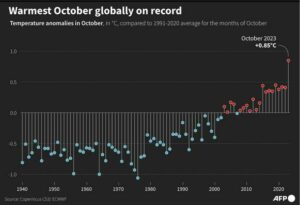Hottest October Globally Marks Fifth Record-Shattering Month
Paris (AFP) – Last month was the hottest October on record globally, Europe’s climate monitor said Wednesday, as months of exceptional heat likely to make 2023 the warmest year in history.
The Copernicus Climate Change Service (C3S) announced that October 2023 was the hottest October ever recorded worldwide. This record-breaking month follows a series of exceptionally hot months, leading scientists to predict that 2023 will be the warmest year on record. The unprecedented rise in temperatures emphasizes the urgent need for world leaders to take immediate action to reduce greenhouse gas emissions. The world leaders are set to convene in Dubai this month for the UNCOP28 climate conference.
According to the C3S, October witnessed droughts in parts of the United States and Mexico, while many regions experienced abnormally wet conditions associated with storms and cyclones. In addition, sea surface temperatures reached their highest levels for October. This phenomenon, driven by global warming, contributes to the intensification and destructiveness of storms.
Samantha Burgess, Deputy Director of the C3S, stated that October 2023 saw remarkable temperature anomalies, continuing the trend of surpassing global temperature records for the fourth consecutive month. She added, “We can say with near certainty that 2023 will be the warmest year on record, and is currently 1.43 degrees Celsius above the preindustrial average. The sense of urgency for ambitious climate action going into COP28 has never been higher.”
 Graphic showing global temperature anomalies for the month of October 2023 compared to the average for the months of October from 1991-2020, according to Copernicus C3S/ECMWF data
Graphic showing global temperature anomalies for the month of October 2023 compared to the average for the months of October from 1991-2020, according to Copernicus C3S/ECMWF data
The Paris Agreement, signed by nearly 200 countries, aims to limit global warming to well below 2 degrees Celsius compared to the pre-industrial era, with a preference for a safer 1.5 degrees Celsius. These benchmarks will be evaluated based on long-term averages rather than individual years.
The El Nino weather phenomenon, which increases temperatures in the southern Pacific and affects global weather patterns, has also contributed to this year’s warming. Scientists anticipate that its most severe impacts will be felt towards the end of 2023 and into the following year.
Furthermore, Copernicus reported that October was 1.7 degrees Celsius warmer than the estimated average for the preindustrial era. Global average temperatures have consistently been the highest since 1940, surpassing the 1.43-degree Celsius mark above the pre-industrial average.
Experts suggest that, considering proxy data such as tree rings and ice cores, this year’s temperatures may be unprecedented in human history, potentially the highest in more than 100,000 years.
The October sea surface temperatures, excluding the polar regions, also reached all-time highs at 20.79 degrees Celsius. Oceans have absorbed approximately 90% of the excess heat generated by human activities since the Industrial Revolution, contributing to the rising intensity of storms and the melting of critical ice shelves that safeguard the large ice sheets of Greenland and Antarctica. These phenomena pose a significant threat of sea-level rise.
Furthermore, warmer atmospheric conditions result in increased moisture, leading to heavier rainfall events.
 Large parts of the world saw wetter-than-average conditions during October
Large parts of the world saw wetter-than-average conditions during October
During the COP28 conference scheduled to take place in the United Arab Emirates from November 30 to December 12, leaders will have to address a critical progress report on the world’s commitments under the Paris Agreement. Recent major scientific reports have confirmed that the world is significantly deviating from its climate goals. Carbon emissions, primarily from fossil fuels, continue to rise, despite the urgent need to reduce them by half this decade.
The adverse impacts of the approximately 1.2-degree Celsius temperature rise from pre-industrial levels are evident in the proliferation of calamitous weather events with substantial financial repercussions. Heatwaves, droughts, and severe flooding have affected various parts of the world, including the United States, China, India, and Canada. In the latter, record-breaking wildfires, partly linked to climate change, resulted in carbon dioxide emissions that exceeded the country’s total 2021 greenhouse gas emissions.
A “State of the Climate” report, published by a group of prominent scientists, warned that humanity has entered “uncharted territory” with warming that endangers life on Earth. Lead author William Ripple, a professor at Oregon State University, noted that annual average temperatures are likely to surpass the 1.5-degree Celsius threshold. He further warned about the increasing dangers associated with climate feedback loops and tipping points, such as ice sheet melting and forest decline. Once these tipping points are crossed, the resulting changes to the climate may be irreversible or extremely difficult to reverse.



























































